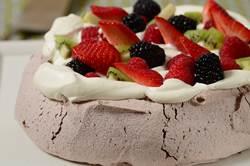|
Chocolate Pavlova: Preheat
your oven to 300 degrees F (150 degrees C). Line a baking sheet with parchment
paper and draw a 7 inch (18 cm)
circle on the parchment paper. Turn the parchment paper over so the circle is on
the reverse side.
In the bowl
of your electric mixer, with the whisk attachment, beat the egg whites and the cream of tartar on
medium speed until you have soft peaks. Then add the sugar, a
tablespoon at a
time, and continue to beat, on high speed, until the meringue is shiny and holds stiff peaks. (Test
to see if the sugar is fully dissolved by rubbing a little of the meringue between
your fingers. The meringue should feel smooth, not gritty. If it feels gritty
the sugar has not fully dissolved so keep beating until it feels smooth.) Then
add the vanilla extract and vinegar and beat until combined. Using a small strainer, sift the cocoa powder and cornstarch over the top of the
meringue and, with a rubber spatula, fold in. If you like you can then fold
in the
chopped chocolate.
Before placing the
meringue on your baking sheet, put a dab of the meringue on the underside of
each corner of the parchment paper. This will prevent the paper from sliding or
lifting up. Then gently pile the
meringue inside the circle drawn on the parchment paper, smoothing the edges.
Place the baking
sheet into the oven and immediately reduce the oven temperature to 250 degrees F
(120 degrees C). Bake the Pavlova for about 60 - 75 minutes or until the outside is dry. (The outside of the meringue will feel firm to the touch,
when gently pressed. There may be some cracks and you will see that the inside is soft and moist.) Turn the oven off, leave the door slightly ajar, and let the meringue
cool completely in the oven (about two hours).
The cooled
meringue can be made and stored in a cool dry place, in an airtight container, for a few days.
Shortly before
serving gently place the meringue on your serving plate. Whip the cold cream and
sugar in your electric mixer, with the whisk attachment (can use a hand mixer or
a wire whisk), until soft peaks form. Mound the whipped cream into the center of
the meringue and arrange the fruit on top of the cream. Serve immediately as
this dessert does not hold well.
Makes 8
servings.
View comments on this recipe on YouTube
|
|

Chocolate Pavlova
Recipe:
4
large egg whites (120 grams),
at room temperature
1/4 teaspoon cream of tartar
(or lemon juice)
1 cup (200 grams) superfine (castor)
sugar
1
teaspoon white distilled vinegar (can use a flavored vinegar)
1/2 teaspoon pure
vanilla extract
1 teaspoon cornstarch (corn flour)
2 tablespoons (15 grams)
unsweetened cocoa powder (Dutch
processed
or regular unsweetened)
1 ounce (30 grams)
semi-sweet or bittersweet chocolate,
chopped (optional)
Topping:
1 cup (240 ml)
cold heavy whipping
cream (cream with a 35-40% butterfat content)
1 tablespoon (15 grams) granulated
white
sugar (or to taste)
Fresh Fruit -
passion fruit, raspberries,
blackberries, strawberries, cherries, peaches, slices of oranges,
gooseberries, and kiwi fruit are some good choices
|